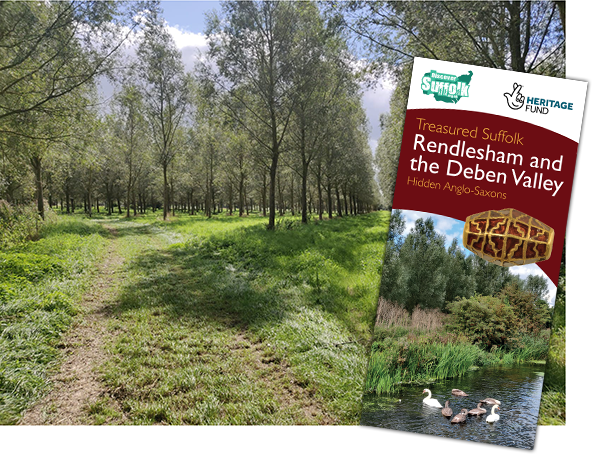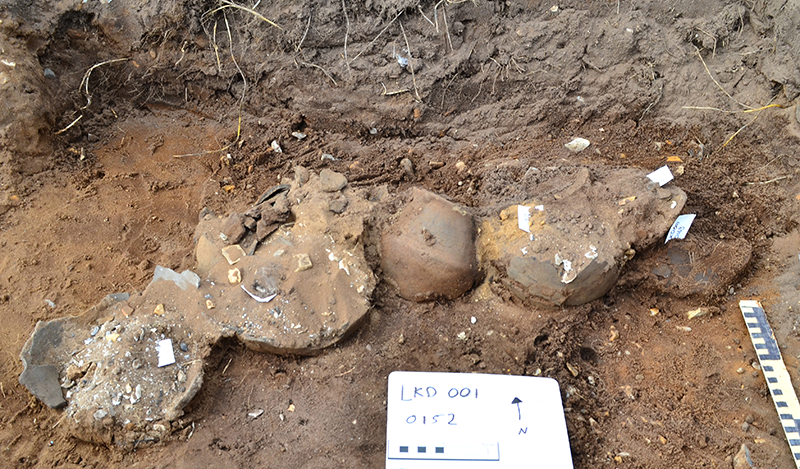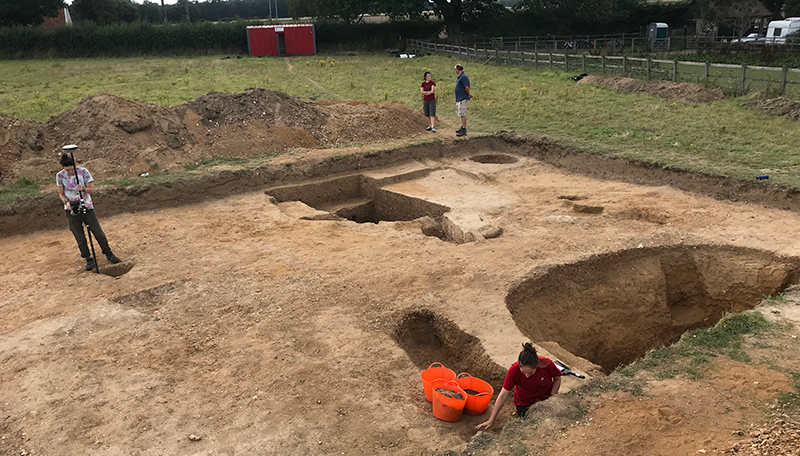
Archaeology News in Suffolk
A collection of archaeological news, projects and events in Suffolk from Suffolk County Council Archaeological Service
Welcome to our e-newsletter for May 2021
Our offices remain closed to the public, but we will continue to keep you updated about the archaeology in Suffolk. Visit our website for advice on accessing our services.
Featured Projects

Image: footpath near Rendlesham and new walking guide
Rendlesham Revealed: Anglo-Saxon Life in South-East Suffolk
Walk in the Footsteps of Anglo-Saxon Kings on new Suffolk Countryside Trail
We have created a seven-mile walking trail in Suffolk’s Deben Valley revealing the hidden archaeological secrets of the area.
Walkers will be transported back 1,500 years and experience the landscape once home to a long-lost Anglo-Saxon settlement at Rendlesham where the East Anglian Kings once lived. Hidden gems from other periods of history will also be unveiled, such as a medieval priory, a stately home, a decoy pond and ancient woodland.
You can download an online guide, which will point out the history along the way, as you explore meadows, open fields, woodland and riverside paths.
The guide is available on the Suffolk Heritage Explorer website at heritage.suffolk.gov.uk/rendlesham
Image: new information boards thanks to funding and support from East Suffolk Lines Community Rail Partnership, the Department for Transport Community Rail Development Fund, Community Rail Network Fund and Greater Anglia.
The trail begins at Wickham Market railway station in Campsea Ashe, with other local railway stations getting involved in the project by installing information boards detailing the local Anglo-Saxon history. Each information board has a QR code which can be scanned to directly download the walking trail guide.
Walkers can choose to extend their walk a few more miles onto Melton train station, where they will pass through the historic town of Ufford, as well as enjoy riverside views of the Deben Estuary, just over the water from Sutton Hoo.
*Fieldwork Update*
We are looking forward to hopefully starting the archaeological fieldwork at Rendlesham later this year, in line with government guidance on covid-19 restrictions. Keep an eye out for updates over the next few months via the e-newsletter, where we will share information on how to get involved.


Image: cremation urns excavated at Lackford in 2016
Investigating Lackford's Anglo-Saxon Cemetery
A new display at West Stow Anglo-Saxon Village and Museum tells the story of Suffolk’s largest Anglo-Saxon cemetery, first discovered in 1945 at Lackford.
West Stow is the site of an early Anglo-Saxon village and is well-known for its reconstructed buildings, giving visitors an immersive experience of Anglo-Saxon life. Archaeologists believe that the people who lived at West Stow during this time may have been buried across the river Lark at nearby Lackford. Over 500 cremations were excavated from the Lackford cemetery in 1947-49 and more of the cemetery was found in 2016.
We now know more about the Lackford cemetery after completing a project re-examining the excavated remains using modern scientific methods.
The story of the Lackford cemetery and many incredible objects from the excavations are on display at West Stow Anglo-Saxon Village and Museum from 17th May 2021 for the next six months.
Plan your visit to West Stow Anglo-Saxon Village and Museum at weststow.org

Image: excavating at Freston © Freston Archaeological Research Mission
Research Dig at Freston's Neolithic Causewayed Enclosure
In 2019, a team from the Freston Archaeological Research Mission investigated the Neolithic causewayed enclosure at Freston in Suffolk. Dr Tristian Carter from McMaster University tells us in his article how the excavations went and what was found.
Causewayed enclosures are believed to have acted as formal gathering spaces for the small-scale and largely mobile farming communities that we associate with Britain’s first farming populations. Freston is one of the five biggest examples of these monuments in England.
The excavations targeted two inner ditch termini, which were over 2 m deep, their bottom layers full of finds – pottery in particular – with over 14 kg of Mildenhall Ware, the distinctive decorated bowls of Early Neolithic East Anglia.
Finds Recording in Suffolk

Image: a pair of flint Bronze Age arrowheads
Featured Find - Bronze Age gold 'penannular ring'
Recovered by a metal detector user near Aldringham cum Thorpe, this artefact was recently declared Treasure at an Inquest held in Suffolk. The core metal of the object is copper alloy, plated with gold. While we term these objects ‘penannular rings’, their precise purpose is unknown. Historically, they have been referred to as ‘ring-money’ and ‘hair-rings’. The uncertainties around their use are complicated by the fact that very few are recorded from secure archaeological contexts.

Image: Covehithe shipwreck remains © Martin Knapp
Shipwreck Remains found at Covehithe
The remains of a ship have recently been spotted by a member of the public on Covehithe beach near Southwold, which could possibly date from the late 17th to 19th centuries. The discovery was reported to the Archaeological Service who passed the details onto the Coastal and Intertidal Zone Archaeological Network (CITiZAN), who are experts in coastal archaeology and run a survey and recording volunteer programme.
Photographs of the wreck give us a glimpse into how the ship would have been constructed.
If you have recently found an archaeological object in Suffolk which you'd like identified and recorded, our Finds Recording Team can help. Find out more about Finds Recording here.
Thank you for joining our e-newsletter, for those who are new, here's a brief summary of what we do.
We are the main provider of archaeological advice in Suffolk and to promote the conservation, enhancement and understanding of Suffolk's distinctive historic environment, we:
- maintain a record of archaeology and heritage assets, the Historic Environment Record
- provide advice to planners, developers and farmers
- identify and record finds made by members of the public
- curate an archive for fieldwork projects carried out in the county
- publish the results of fieldwork and other research into Suffolk's past